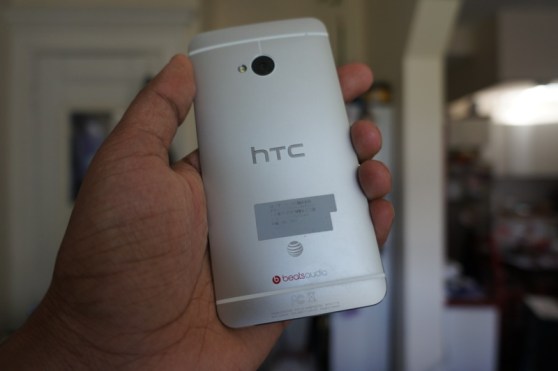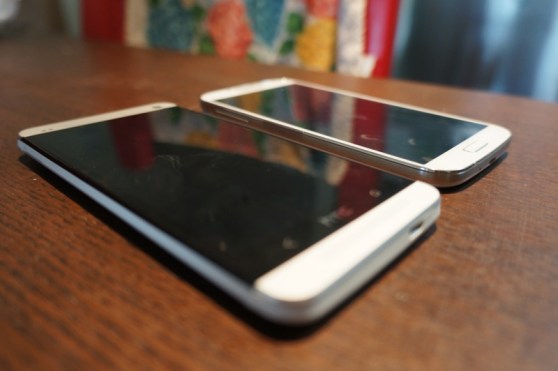
Finally, there’s an Android phone that doesn’t make me miss anything about the iPhone. It’s called the HTC One, and it’s the best Android phone I’ve ever laid hands on.
It might also be the best smartphone I’ve ever used.
That’s saying a lot. Until now, the iPhone 5 embodied everything I wanted in an ideal smartphone: a solid-yet-elegant design, seemingly limitless speed, and a great screen. Android phones have certainly come close, but up until now there’s always been something that inexplicably held them back: the Nexus 4’s lack of LTE, the Galaxy S4’s cheap-feeling plastic case, or Android’s own design immaturity until Android 4.0.
What makes the HTC One so great? Simply put, it’s a phone that never leaves me wanting. It has a great camera, it’s freakishly fast, and its screen is fantastic without needing to be oversized. It also packs in several features I never thought I’d want in a smartphone but that I’ve found myself coming back to quite a bit.
Did I mention it’s gorgeous? Holding the HTC One in your hand will instantly make your current phone seem cheap and dated. Yes — even if your current phone is an iPhone 5.
Perhaps most of all, I appreciate HTC’s restraint. Unlike Samsung’s pile-on of features and questionable technology in the Galaxy S4, just about everything in the HTC One feels like a deliberate choice meant to create a better experience. That’s important, as it may just be the company’s last chance to turn its dismal fortune around.
It’s just too bad that most buyers will probably ignore it.
The good: It inspires pure gadget lust
The HTC One is so striking that strangers didn’t hesitate to ask me questions about it. “What is that?,” was a common refrain among New Yorkers as I was testing the phone throughout the city. I could tell they noticed it wasn’t just another Galaxy S or iPhone. It was something completely different — and they just had to know more.
One young couple I talked to, both Android owners, immediately noticed that the HTC One felt more substantial than the Galaxy S phones because of its solid metal case. They also appreciated the clean design of the phone, as well as HTC’s Sense software, which they noted was more tasteful and less intrusive than other Android phones they’ve used. These weren’t gadget geeks either, which made the conversation all the more intriguing.
I’ve tested plenty of phones in New York City, and the HTC One has managed to get me more attention than any other phone from random passersby.
You can chalk up its immediate appeal to that case, which is carved out of a single piece of metal and evokes Apple’s MacBook Air. HTC stacks the phone’s hardware to take full advantage of its limited internal space, which makes for a slightly rounded rear that fits comfortably into your hand. The HTC One feels like an evolved form of last year’s One S, which was one of my favorite Android phones so far. (Since it was only available on T-Mobile in the U.S., most people didn’t even know it existed.)

From afar, the HTC One looks similar to the iPhone 5, but up close it’s distinctly different. The One’s 4.7-inch screen commands most of its front, and it’s flanked by noticeable-yet-attractive speaker grills. Its screen is bright and vibrant with a sharp 1080p display. It even looked flawless under direct sunlight while wearing polarized sunglasses.
I initially thought the One’s stereo speakers were a gimmick (who really uses their phone like a boombox?), but I’ve grown to enjoy its ability to project decent audio. It’s particularly great for watching YouTube videos with friends — and it’ll amaze people used to tinny smartphone speakers. The One also includes Beats Audio support, but, as always, its impact on music quality felt negligible aside from making things a bit louder.
Under the hood, the One packs in a quad-core Qualcomm Snapdragon 600 processor running at 1.7 gigahertz, as well as 2 gigabytes of RAM. Those are the same basic specs as Samsung’s Galaxy S4, and you can be sure that most other new Android phones will match it as well. For the most part, that means you can expect similarly fast speeds across most modern Android devices. The big differentiators for smartphones now are build quality, style, and features — all of which the One excels at.
It’s been a while since I’ve been unable to keep my hands off of a piece of tech, but the One’s combination of confident style, speed, and useful features has made it my go-to gadget over the last few weeks (beating out the iPhone 5 and iPad Mini).

Above: Taken with the HTC One in NYC’s Central Park.
A different kind of smartphone camera
While most other smartphone makers are racing to pack in as many megapixels in their cameras as possible, HTC went in a completely different direction with the One. Its camera only offers 4 megapixels, but it makes up for that low figure with Ultrapixel technology, which lets in more light than typical smartphone camera sensors. That means the One should be better equipped than most other smartphones to take shots at night.
The One’s camera is also optically stabilized, making it better suited for low-light shots without blur and video without too much shakiness. The One’s night capabilities are helped by an incredibly low f/2.0 aperture, which camera geeks will surely appreciate.
http://www.youtube.com/watch?v=nE8PBoL0CO
Nokia’s photo-friendly Lumia 920 is the only smartphone on the market that can compete with the One’s camera specs. The iPhone 5’s 8-megapixel shooter doesn’t have optical stabilization and it has a higher f/2.4 aperture (so it takes in less light than the One).
I found the One’s camera excelled at low-light shots. Daytime shots weren’t always as clear as higher megapixel cameras from the iPhone 5 (8MP) and Galaxy S 4 (13MP). Still, I preferred the flexibility of taking decent low-light photos without the need for a harsh flash. That’s something professional photographers strive for with their expensive cameras and lenses. And as you can see from the photos below, the One’s day shots still look pretty great.
Stretching the functionality of its camera even further, the One includes a new feature dubbed HTC Zoe. Once enabled, Zoe records a short 3-second video and up to 20 still photos whenever you take a shot. It’s a nice way to make sure you don’t miss a single moment, and it’s fun to see the Zoe clips alongside your static photos. For the most part though, I haven’t found too much use for Zoe.
I respect HTC’s bold camera approach with the One, as it both attacks the megapixel myth head-on (the idea that higher megapixels instantly means better pics) and offers a solution that works well for the way we take pictures today. Ultimately, cellphone camera pictures will most likely end up on Facebook or Instagram, not in a framed photo on your mantle. And with storage space a priority on smartphones, it makes more sense to focus on higher-quality images that are reasonably sized, rather than huge files from a high-megapixel camera.
Software you’ll actually use
In my review of last year’s HTC One S, I called for the death of the company’s Sense Android skin, which slowed down an otherwise fantastic phone with tons of software bloat. Well, I didn’t get my wish this time around, but I have a feeling HTC has been listening to complaints.
The company’s updated Sense 5 skin is stripped down and never gets in your way. It’s focused mostly on a single screen called the BlinkFeed, which is sort of what you’d get if you mixed together social media and news updates from Flipboard and Pulse with Windows Phone’s flat home screen tiles. The BlinkFeed is a core part of HTC’s home screen, so you’re typically never more than a few swipes away from it.
While it’s certainly no replacement for a dedicated news application, I grew to love sifting through news updates during my idle time. The BlinkFeed is perfect for when you want to glance at the news but don’t feel like digging through your news app.
HTC has also revamped its music player and created a new TV app as part of the new Sense. Powered by technology from the startup Peel (which also powers Samsung’s similar app on the Galaxy S4), the TV app lets you control your home entertainment system and keep an eye on what’s on the air. The One’s power button doubles as an infra-red sensor, which means it can control practically anything that relies on a traditional remote control.
Even though I’m an unabashed couch potato, I still haven’t found much of a reason to use a smartphone to replace my remote controls. The One’s TV app is a decent effort, though, and it could appeal to people tired of juggling multiple remotes at home. And I’m sure some fans will appreciate never having to leave the glow of the HTC One’s screen just to change the channel.
With Sense’s new diet and focus on useful features, you could say that it finally makes sense.
The bad: Not much
It’s rare that I don’t have many negative things to say about a smartphone, but there’s just not much to complain about with the HTC One. One minor issue may bother some buyers though: It only has two capacitive buttons — a back button and a home button.
You can double-tap on the home button to access all of your running apps, which takes some getting used to at first but quickly becomes second-nature. Just like HTC’s previous One models, there’s nothing that takes the place of the standard Android menu button, which was used in the past (and is still used on some new phones) to display additional options for an app.
Google deprecated the menu button last year (a signal to developers that they should stop supporting it), but plenty still haven’t updated their apps to take advantage of the new interface guidelines. For HTC One users, that means they’ll see a black bar at the bottom of the screen that simulates the Android menu button of yore. It’s only a few pixels tall, but it’s an eyesore every time it pops up. (Twitter recently updated its Android app to remove its reliance on the old menu button, so it seems that Android devs are finally paying attention to Google’s changes.)
Is this enough to save HTC?
HTC builds great phones, but nobody seems to notice. For its last quarter, the company reported a massive revenue fall of 98 percent compared to the same quarter last year. Indeed, HTC has fallen far from its position as the top Android phone maker in 2010.
For the most part, it was blindsided by Samsung’s strategic efforts with the Galaxy S series, which debuted simultaneously across all U.S. carriers and were backed by massive marketing efforts. Last year HTC tried to change things up by focusing on just a few flagship devices, the One S and One X, but it couldn’t compete with the hype from the Galaxy S3 and iPhone 5.
HTC was so eager to differentiate itself from the Android pack that it invested an insane $300 million in Beats Electronics in 2011, which granted it exclusive access to Beats technology for its phones. But despite the hype around audio gear right now, Beats didn’t help HTC ship phones. HTC ended up rebuying $150 million worth of shares from Beats a year ago (though it’s still the largest shareholder).
You can feel HTC’s desperation in the One. That metal case and obsessive design doesn’t come from a company that’s sitting pretty with success. Plenty of gadget geeks I know can’t wait to get their hands on it. And as I described above, it simply mesmerizes anyone who sees it.
The real tragedy is that, to a certain degree, it doesn’t matter if the One is the best smartphone ever made. HTC still doesn’t have the marketing muscle to take on Apple and Samsung, which means it’s going to have a hell of a time trying to make general consumers aware of the One.
Peter Chou, HTC’s CEO, promised during the company’s most recent earnings call that it will focus more on marketing this time around. But HTC will need more than just a big marketing budget to make an impact — it also needs an interesting way to make consumers pay attention.
If you want to see just how screwed HTC is, walk into one of the 1,400 Best Buy stores that feature Samsung’s Experience Centers. Like miniaturized Apple stores, Samsung’s ministores are staffed with people who are trained in its products and ready to convince people to buy them. They also take up quite a bit of floorspace. In New York City, I’ve sometimes had trouble finding other Android smartphones amid the Samsung marketing bonanza.
What’s worse is that Best Buy has actually gone on record supporting the One, we’re just not seeing that reflected in stores. Best Buy marketing head Allister Jones went so far as to say the company “needed HTC back in the market” during the One’s unveiling.
At this point, it’s too early to read much into HTC’s One sales. But things may be getting better: HTC is projecting that it will earn $1 billion more this quarter than it did in the last, likely based on estimated sales of the One. If HTC fails to meet its own projections, though, the One could end up being its last great phone.
The verdict: Just buy it already!
There’s a good chance we’ll look back at the HTC One as a turning point for Android. It’s the first time build quality for an Android phone has reached Apple levels of obsession, and it also shows off just how far Android and HTC have come over the past few years.
The HTC One is currently available on AT&T and Sprint starting at $200 with a two-year contract, as well as on T-Mobile for $100 (plus $2o a month for 24 months).
With the iPhone 5, Galaxy S4, and HTC One on the market, it’s a good time to be looking for a smartphone. They’re all solid choices — but if I had to pick just one, I’d recommend the One wholeheartedly. It’s not just a great phone, it’s a rare piece of technology that instantly makes everything before it seem less interesting.
If this is HTC’s swan song, it sure is a memorable one.
Photos: Devindra Hardawar/VentureBeat
VentureBeat's mission is to be a digital town square for technical decision-makers to gain knowledge about transformative enterprise technology and transact. Learn More




















